IBM’s latest slogan is “We can make a smarter world” or something idiotic like that”¦ here, again, in a dumb marketing campaign we immediately confront the basic problem. The world is an incredible intelligence already. We humans really don’t understand it well at all”¦ It might make sense for a corporation like IBM to invite us to become smarter by learning more about natural systems, how we can redesign our existence on a paradigm of sensible insertion into those natural systems, but to hubristically claim that corporations could” or worse, should” go about “making” a “smarter world,” is just breathtakingly dumb.
Not that I expect anything different from corporations. They are always filling our mental and social spaces with their insipid messages. Once in a while they have a bad moment, like yesterday when Royal Dutch Shell Oil Company decided to settle out of court for about $15 million rather than face the shitstorm of bad publicity that a trial was going to put them through. The case was brought by the relatives of Ken Saro-Wiwa, a Nigerian activist of the Ogoni people who was murdered by the Nigerian government in an unsuccessful effort to quell the ongoing resistance in the Nigerian Delta to the incredible mayhem, death and pollution wrought by multinational oil companies like Shell and Chevron.

Image drawn by Jim Swanson in 1996, dramatizing the murder of Ken Saro-Wiwa by the Nigerian military and its multinational sponsors.
It was a small but important step towards ending the impunity with which multinational corporations are able to wreak havoc across the planet. Another exciting development just happened yesterday when the Peruvian congress voted to suspend two laws that had been shoved through by the neoliberal Alan Garcia regime, using the Free Trade agreement with the U.S. as a pretext, which were designed to remove the traditional land-tenure rules that preserved indigenous cultures against global energy giants. Mass protest in the Amazonian part of Peru led to a horrible massacre of 500 people by the Peruvian military last week, and now the national parliament has entered the fray to try to defuse the situation. Kudos to the intense organizing and protest of the Peuvian indigenous who have, temporarily at least, halted the oil and timber companies.
The growing efforts locally to begin “transition towns” and find ways to plan for “energy descent,” to “relocalize“ the economy, etc., are important examples of a global shift underway. We might think growing tomatoes in a community garden is just a hobby, or choosing to bicycle is a simple and narrow “consumer” choice, but actually these are part of the bigger conflict that is unfolding, which the Peruvian Indians are on the front lines of, as we are in our less sensational and more modest efforts here. But it behooves us to make the connections whenever we can. Slowly but surely editorials and books are appearing that are starting the difficult but inescapable task of ending the dictatorship of “Growth” as the reigning measurement of our lives. Gar Smith wrote a good piece in the latest issue of Earth Island Journal called “Planet Girth,” which is mostly framed around population and resource depletion, but after a while gets to the point:
“Meeting the “˜growing demands of a growing population’ [as IBM and Chevron and Monsanto like to frame their profit-driven strategies] is not solving the problem: it is perpetuating it”¦ When it comes to debating long-term survival, the English language has shortchanged us. We have no antonym for the word “growth.” As a consequence, the opposite of “growth” has come to mean “death” or “decay.” If we’re going to have an honest dialogue on a linguistically even playing field we need a new word. A EIJ writer once suggested “shrinkth.”
I like better the name taken by a small group of Italians on the east coast of central Italy: Descrescita Feliz, or “Happy Degrowth,” but you see the problem. Nothing really sounds right in English. Anyway, the localizing impulse is much more than just a turn to the neighborhood or the community, though it is that too. It is also a battlefield in a war for the future, a war that is being waged with military resources and state-of-the-art propaganda in all regions by the behemoths that have done so much to ruin life already. We have to get a lot better at describing how much better life can be than what we’ve got now. Part of that is describing our reconnection to ecological sanity, but equally important is to use the technological and social resources we have to produce together a materially and emotionally fulfilling life. Couching our arguments in terms of sacrifice, loss, depletion, collapse, et al, is to lose the point. We may indeed end up using a lot less resources when we get “done” restructuring how we live together; I hope so! But to start a political argument by emphasizing that is to play into the hands of more than a century of propaganda in favor of more, bigger, progress, etc. We have to reappropriate “˜progress’ and “˜better’ from the banal stupidity of more and bigger”¦Quality over quantity anyone?
One of the key parts of this transformative agenda is the re-establishment of a public sphere, a growing of the public commons, and a general surge towards decommodifying as much of life as we can, as soon as we can. In San Francisco over the past two weeks there’s been a lovely embrace of public space that never fails to hearten me and spark a lot of excitement among many locals.
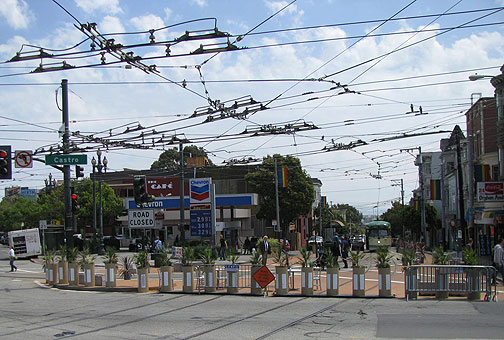
The newly closed 17th Street plaza at Castro and Market.
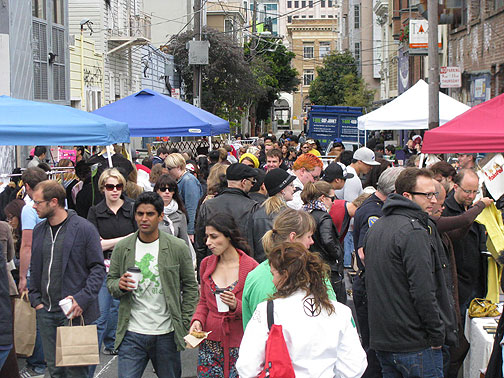
At Lilly Alley and Octavia a small street fair (staged by the Union Project: http://www.unionproject.org/About_Us) was held over Memorial Day weekend, with locals jamming the area to browse the goods. A commercial use of public space, but with locally made goods and a lot of conviviality in the streets.
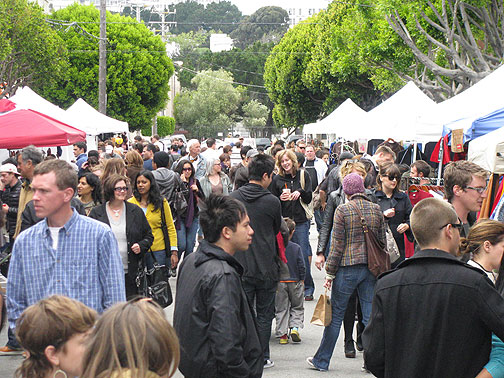
Just off the end of the Hayes Green on Octavia Street.
Of course we had Critical Mass at the end of May, and it was its usual rambunctious self, rolling all over town and up and over Lombard again. I missed a lot of it, bailing early this time, but glad to have a toe in it for a little while.
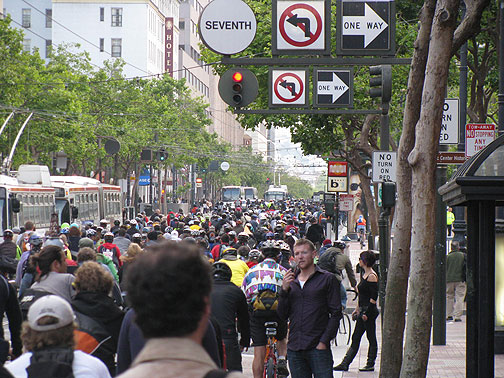
Surging up Market at 7th.
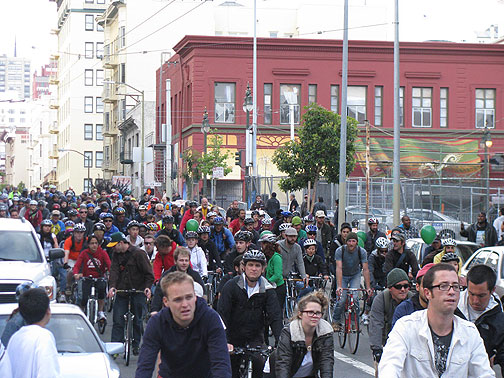
Rolling down Jones past the new mural at Golden Gate towards Market.
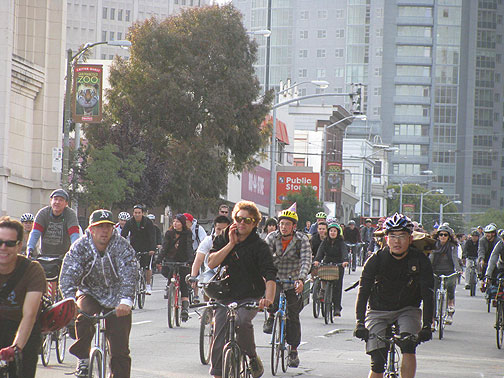
Southbound on 10th Street near Folsom.

They headed back east on Folsom, I went home!
A week later, on Saturday June 6, a fun combination of spontaneity and planning led to a rich evening in the Mission. Local Salvadorans erupted in celebration when their national team defeated Mexico 2-1 in a World Cup qualifier in San Salvador. They poured into the streets and soon there were flag-draped caravans crisscrossing the neighborhood, horns blaring. While that was happening, the MAPP was on too, the Mission Arts and Performance Project, which happens the first Saturday every other month. About a dozen and a half backyards, garages, storefronts and cafes open from 7-11 or so, hosting an incredible number of poets, musicians, performance artists, and visual art shows. In the streets, hundreds or thousands of neighbors stroll from place to place, stopping on street corners to chat and mingle with friends old and new. And at 24th and Mission, once known as Plaza Sandino, Deep threw up his sound system for the latest installment of “FlashDance” a flashmob-style dance party that never fails to get a hundred-plus people boogeying and sweating together, grinning like fools, inviting in unsuspecting passersby.
The next day was Sunday Streets, and this time it was held through the heart of the Mission, stretching from Dolores Park down 19th street, across Valencia to 24th, down 24th all the way to York, and then weaving over to Rolph playground at Potrero and Chavez. Wow! It was amazing! Thousands of people turned out from 10-2 while the streets were closed. Little children cavorted on bikes through the streets, people milled about talking, there were dances and musicians, rollerskating and bicycling, people passed through the crowd handing out free marijuana, water, and more. A bit of the Burning Man ethic of gifting took over unexpectedly and instead of the whole thing being dominated by booths and goods for sale, the few tables that were out were mostly local service organizations promoting their activities, a smattering of lemonade stands, and otherwise it was just people having a great time using the asphalt for something other than car storage and movement! Here’s a gallery:
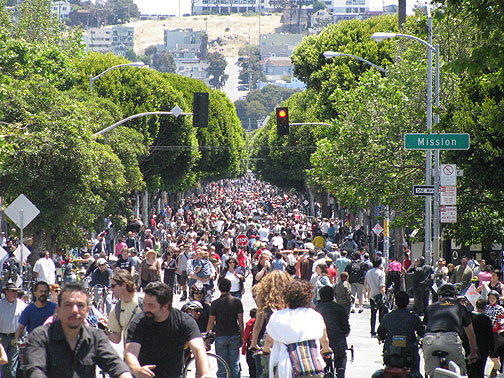
24th Street east from Valencia, Sunday, June 7, 2009.
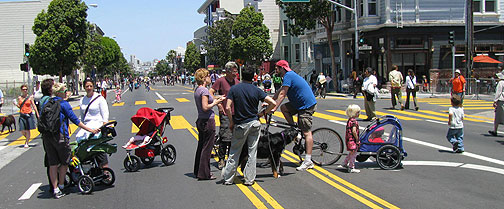
Hanging in the street, Valencia and 23rd.
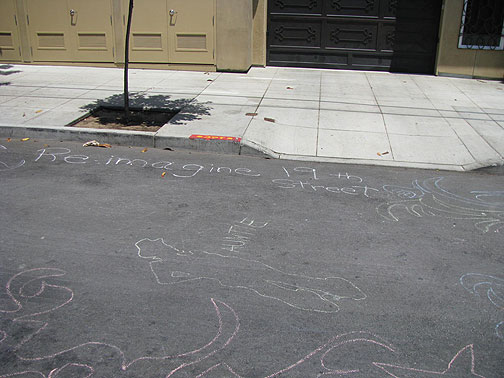
Re-imagine 19th Street!

24th and Folsom.
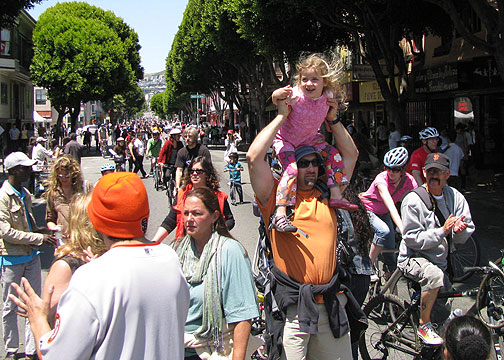
Kids and parents everywhere, having a great time!
The next one is July 19, same locale in the Mission. Don’t miss it! Lastly, since I don’t post as often as I’d like to, I have some photos from early June that are just darn purty… so here’s an additional photo gallery for the hell of it!
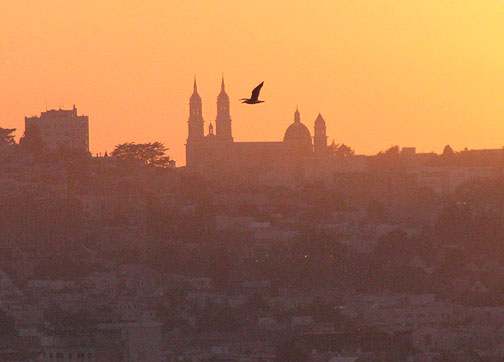
A sunset shot from the Potrero Hill Community Garden towards St. Ignatius at USF… a seagull crashed the photo, serendipitously!
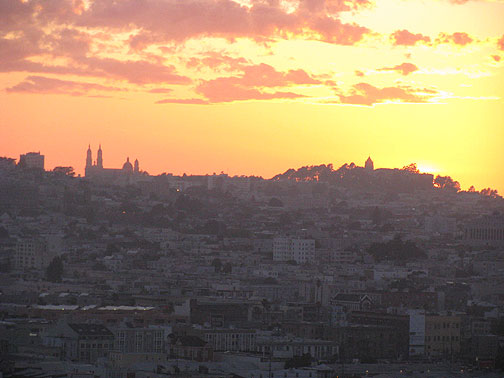
Similar view without the zoom (or the bird!)
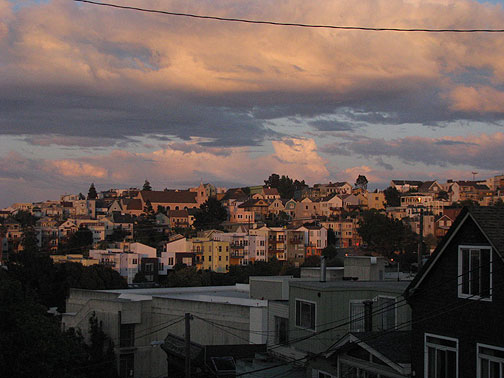
Easterly view from Permaculture Garden at 18th and Rhode Island on Potrero Hill.
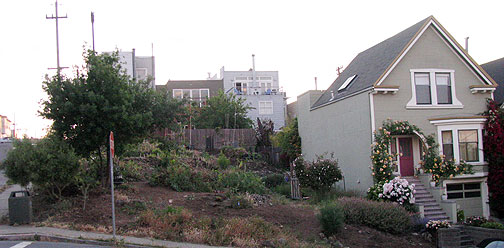
This plot of land has been dedicated by its owner to a Permaculture garden, 18th and Rhode Island.

Artichokes at the Potrero Hill Community Garden, Vermont at 20th.
And for the climax, a shot of the moon an hour after its rise over San Francisco. We saw it far north near Petaluma, where the blood red moon was astonishingly large at the horizon when it first peeked over the edge… but we didn’t get to stop for photos until above the Golden Gate Bridge…












